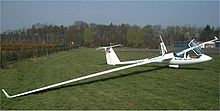Alexander Schleicher
| Alexander Schleicher GmbH & Co.
|
|
|---|---|
| legal form | GmbH & Co. |
| founding | 1927 |
| Seat | Poppenhausen , Germany |
| management | Peter and Ulrich Kremer |
| Branch | Aircraft construction |
| Website | www.alexander-schleicher.de |
The Alexander Schleicher GmbH & Co. is a German glider manufacturer headquartered in Poppenhausen (Wasserkuppe) in the district of Fulda in Hesse . The company has around 105 employees and produces around 90 to 100 gliders a year. 65% of the aircraft are exported abroad.
Important aircraft types from this manufacturer were Rhönlerche Ka 4 , Ka 6 , K 7 , K 8 , ASK 13 , ASK 21 , ASW 12 , ASW 15 , ASW 17 , ASW 19 , ASW 22 , ASW 24 , ASH 25 , ASH 26 , ASW 27 , ASW 28 and ASG 29 . The latest available on the market developments, the ASG 32 , ASH 31 Mi and the ASH 30 Mi . In 2018 theAS 33 , a new 15- and 18m-class glider and successor to the ASG 29 , and in 2019 the AS 34Me, a self-launching further development of the ASW 28 with electric drive, announced.
Many of these aircraft were milestones in the development of gliders and were used for record flights, for example Hans-Werner Grosse flew with the ASW 12 on April 25, 1972 from Lübeck to Biarritz in France, a new world record for gliders with 1460 km. Even today, Alexander Schleicher GmbH is one of the leading sailplane manufacturers.
Since the introduction of the ASW 12, the names of the aircraft types have always been assigned according to the same pattern: AS for Alexander Schleicher , followed by the first letter of the name of the aircraft designer. The number is the consecutive numbering of the aircraft types. The ASK models by Rudolf Kaiser , the ASW models by Gerhard Waibel , the ASH models by Martin Heide and the ASG models by Michael Greiner were developed. It is not until the types AS33 and AS34Me that the designer is not named, since the design is now carried out in a team.
history
After training, traveling and working for Weltensegler GmbH on the Wasserkuppe, the trained carpenter Alexander Schleicher (1901–1968) founded the factory in Poppenhausen in 1927 . Schleicher won the training competition of the Rhön glider flying competition in 1927 with a self-made “Get the Devil”. The prize money formed the basis for acquiring his own workshop space. The area on Huhnrain in Poppenhausen, which is still in use today, was moved into in 1931. In the following years, the company operating under the name Segelflugzeugbau "Rhön" Alexander Schleicher mainly manufactured aircraft by the designers Alexander Lippisch and Hans Jacobs in series, as well as one-offs such as the research sailor "OBS" from the Rhön Rossitten Society .
In 1936 the company had 50 employees. In 1939 there were already 120 employees. After the start of the war, the company continued to build gliders for NSFK and Luftwaffe and served as a repair shop. From 1943 so-called "Kunz-Schuler", ground exercise devices that were used in the beginner training, were built on behalf of the Reich Aviation Ministry .
After the end of the war, aircrafts were no longer allowed to be manufactured between 1945 and 1951, so furniture was built until the resumption of gliding. Rudolf Kaiser joined the company in 1952 as an aircraft designer.
In 1963 began Gerhard Waibel , GfK developing airplanes. Martin Heide expanded the company as a further aircraft designer in 1981.
The access road to the company premises was renamed Alexander-Schleicher-Straße in 2003. Gerhard Waibel retired in the same year after 39 years.
Airplane types (from 1952)
( see also : List of aircraft types manufactured by Schleicher )
Single seater
- Schleicher Ka 1 Rhönlaus
- Schleicher Ka 3
- Schleicher Ka 6 , also as Ka 6 B, Ka 6 BR, Ka 6 BR-Pe, Ka 6 C, Ka 6 CR, Ka 6 CR-Pe, Ka 6 BR-S, K 6 E
- Schleicher K 8 , also as K 8 A, K 8 B
- Schleicher K 9
- Schleicher K 10
- Schleicher K 11 motor glider, only a prototype was built as a development study for the ASK 14.
- Schleicher ASW 12
- Schleicher ASK 14 motor glider
- Schleicher ASW 15 , also as ASW 15B
- Schleicher ASW 17
- Schleicher ASK 18
- Schleicher ASW 19 , also as ASW 19B
- Schleicher ASW 20 , also as ASW 20B, L and top
- Schleicher ASW 22 , also as B, BL, BLE ( Open Class )
- Schleicher ASK 23
- Schleicher ASW 24 , also with motor as ASW 24E
- Schleicher ASH 26 , also with motor as ASH 26E
- Schleicher ASW 27
- Schleicher ASW 28 , also as ASW 28-18 and with motor as 28-18 E.
- Schleicher ASG 29 , with motor as homecoming aid as ASG 29E
- Schleicher ASH 31 Wed
Two-seater

- Schleicher Ka 2 Rhönschwalbe, also as K2b
- Schleicher Ka 4 Rhönlerche
- Schleicher K 7 Rhön eagle
- Schleicher ASK 13
- Schleicher ASK 16 motor glider
- Schleicher ASK 21 , also with motor as ASK 21 Mi
- Schleicher ASW 22-2, prototype of the ASH 25 ( open class )
- Schleicher ASH 25 , also with motor as ASH 25E, M and Mi or as ASH25 EB27 and ASH25 EB28
- Schleicher ASH 30 Wed
- Schleicher ASG 32 , also self-starting as ASG 32Mi and with electric homecoming aid ASG 32EL
literature
- Richard Ferrière / Peter F. Selinger: Rhönsegler. Alexander Schleicher's gliders and motor gliders 1951–1987. Motorbuch Verlag, Stuttgart 1988.
Web links
- Alexander Schleicher GmbH & Co. Glider construction. In: alexander-schleicher.de. Alexander Schleicher, accessed on April 11, 2011 (manufacturer homepage).
Individual evidence
- ↑ Alexander Schleicher is one of the world's leading sailplane manufacturers ( Memento from June 14, 2010 in the Internet Archive ) (www.luftfahrtlexikon.net)


